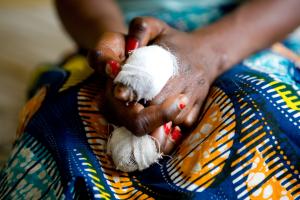Better testing boosts leprosy response in the Democratic Republic of the Congo
Kinshasa – Yole Monlwa, 22, vividly remembers the day he heard a radio broadcast on the importance of testing for leprosy.
“At the time, I could not feel my hand, nor even move my fingers. I had had two ineffective treatments. I went with my parents to the hospital mentioned on the radio, and was told I had leprosy.”
After 14 months of treatment and a long isolation period to avoid infecting people around him, Monlwa is cured.
“I didn’t know this disease well,” he says from his house in Kalamu, a municipality of Kinshasa, the capital city of the Democratic Republic of Congo. “I encourage people to seek information and get examined before their condition becomes worse.”
The young man is among over 4,000 leprosy cases detected last year in the Democratic Republic of the Congo. Thanks to financial support of the Sasakawa Health Foundation, the detection of the disease has been strengthened in nine provinces where it is endemic. A total of 1075 additional cases have been diagnosed and treated, including 108 children.
Leprosy is a chronic infectious disease caused by the Mycobacterium leprae bacillus. It affects the skin, the peripheral nerves, the mucosa of the upper respiratory tract, and the eyes. Early symptoms include discolored patches of skin that are painless and do not itch. A disability then develops over a few years, which explains why many people are diagnosed late.
Untreated, leprosy can cause progressive and permanent damage to the skin, nerves, limbs, and eyes.
Sasakawa Foundation support helped train 720 community teams to conduct awareness-raising activities. In addition, 54 teams and 180 nurses from various health zones learned to identify early symptoms and examine community contact cases.
“We can raise awareness in churches, schools, markets, and in the streets with loudspeakers, as well as through community radio stations,” says Dr Florent Ngondu, Director of the programme for the elimination of leprosy at the Ministry of Health. “It has triggered not only a surge of presumed cases among which leprosy has been detected, but also cases of scabies, mycosis, vitiligo and other skin afflictions.”
Other tropical neglected diseases were also detected, including 93 cases of yaws and 45 suspected cases of Buruli ulcer.
In the Democratic Republic of the Congo, “the national programme for the elimination of leprosy is integrated into the activities of health facilities,” says Dr Ngondu. “Health workers and community members who took part in testing activities will be able to continue detecting and guiding suspected cases, as well as to treat and monitor patients.”
In the African region, 46 countries have eliminated leprosy as a public health problem, and the number of new detected cases has decreased from 52,767 in 2000 to 17,887 in 2020 – a 66% decrease.
“Sasakawa Foundation’s invaluable support is part of the WHO global leprosy strategy 2021-2030, which aims to reach zero infection and disease, zero disability, zero stigma and discrimination,” says Dr Amédée-Prosper Djiguimde, WHO representative in the Democratic Republic of Congo. “We must now sustain these good results in order to spare everyone from suffering from leprosy.”Communications Officer
WHO DRC
Tel : +243 81 715 1697
Office : +47 241 39 027
Email: kabambie [at] who.int (kabambie[at]who[dot]int)
Communications and marketing officer
Tel: + 242 06 520 65 65 (WhatsApp)
Email: boakyeagyemangc [at] who.int (boakyeagyemangc[at]who[dot]int)
